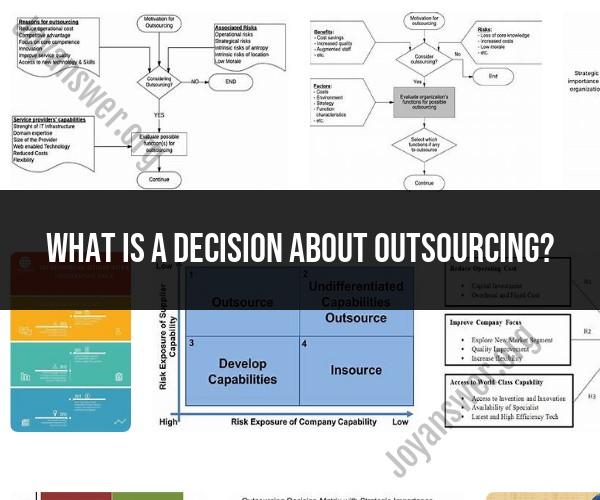What is a decision about outsourcing?
A decision about outsourcing refers to the process of evaluating whether to delegate specific business functions, tasks, or processes to external third-party service providers rather than handling them in-house. Outsourcing is a strategic business practice that organizations use to access specialized expertise, reduce costs, and focus on their core competencies. Making a decision about outsourcing involves considering various factors and conducting a comprehensive analysis. Here are some key aspects to consider when making a decision about outsourcing:
Cost Analysis: Assess the costs associated with outsourcing compared to the costs of handling the tasks internally. Consider factors such as labor, technology, infrastructure, and overhead expenses.
Core Competencies: Determine whether the task or function being considered for outsourcing is a core competency of your organization. Core competencies are the unique strengths and capabilities that set your business apart.
Expertise and Quality: Evaluate whether the outsourcing provider possesses the expertise and resources needed to deliver the required quality of service. Check their track record and references.
Scalability: Consider whether outsourcing allows your organization to scale operations up or down as needed. This flexibility can be valuable in a dynamic business environment.
Risk Assessment: Analyze the potential risks associated with outsourcing, including data security, confidentiality, regulatory compliance, and the reliability of the service provider.
Service Level Agreements (SLAs): Define clear SLAs with the outsourcing provider. These agreements should outline expectations, performance metrics, and penalties for non-compliance.
Location: Decide whether the outsourcing provider should be located domestically or internationally. The choice may impact factors such as communication, time zones, and labor costs.
Impact on Employees: Consider the impact of outsourcing on your existing workforce. Will it lead to layoffs, retraining, or a shift in employee roles?
Cultural Fit: If outsourcing internationally, assess whether there are cultural and language barriers that may affect communication and collaboration.
Regulatory and Legal Compliance: Ensure that the outsourcing arrangement complies with all relevant laws and regulations, both in your country and the outsourcing provider's location.
Transition Plan: Develop a well-thought-out transition plan for transferring responsibilities to the outsourcing provider. This plan should minimize disruptions to your business operations.
Long-Term Strategy: Consider the long-term implications of outsourcing. Does it align with your organization's strategic goals and growth plans?
Return on Investment (ROI): Calculate the expected ROI of outsourcing by comparing the benefits (cost savings, improved efficiency) to the expenses (service provider fees, transition costs).
Communication: Establish effective communication channels and protocols with the outsourcing provider to ensure transparency, collaboration, and problem resolution.
Exit Strategy: Develop an exit strategy in case the outsourcing arrangement needs to be terminated or transitioned to a different provider.
The decision about outsourcing is not one-size-fits-all and should be based on the unique needs and circumstances of your organization. Careful analysis and consideration of these factors can help you make an informed decision that aligns with your business objectives and enhances overall efficiency and competitiveness.
The Outsourcing Decision: Factors to Consider and Steps to Take
Outsourcing is the process of contracting out certain business functions or operations to a third-party provider. It can be a strategic way to reduce costs, improve efficiency, and gain access to specialized expertise. However, it is important to carefully consider all of the factors involved before making an outsourcing decision.
Factors to consider:
- Cost: Outsourcing can help to reduce costs by eliminating the need to hire and train in-house staff, and by leveraging the economies of scale of the outsourcing provider. However, it is important to factor in all of the costs associated with outsourcing, such as vendor fees, transition costs, and ongoing management costs.
- Quality: It is important to choose an outsourcing provider with a good track record of providing high-quality services. Be sure to get references from other customers and to carefully review the provider's contract before signing.
- Security: If you are outsourcing sensitive data or processes, it is important to choose a provider with strong security measures in place. Be sure to ask about the provider's security policies and procedures before signing.
- Control: When you outsource, you are giving up some control over the business functions or operations that you are contracting out. It is important to manage this relationship carefully and to have a plan in place in case of any problems.
Steps to take:
- Identify the business functions or operations that you want to outsource. Make a list of the functions or operations that you are considering outsourcing, and assess the pros and cons of outsourcing each one.
- Develop a set of selection criteria. Decide which factors are most important to you when choosing an outsourcing provider, such as cost, quality, security, and experience.
- Research outsourcing providers. There are many different outsourcing providers available, so it is important to do your research to find one that is right for your business. Get quotes from multiple providers and compare their services and pricing.
- Select an outsourcing provider. Once you have researched multiple providers, select the one that best meets your needs. Be sure to negotiate a contract that clearly outlines the services to be provided, the costs involved, and the performance standards.
- Implement the outsourcing relationship. Once you have selected an outsourcing provider, you will need to implement the relationship. This includes developing a transition plan, training the provider's staff, and establishing communication and reporting procedures.
- Manage the outsourcing relationship. It is important to manage the outsourcing relationship on an ongoing basis. This includes monitoring the provider's performance, providing feedback, and making changes to the relationship as needed.
Deciding on Outsourcing: A Guide to Making Informed Choices
Making an informed decision about outsourcing requires careful consideration of a number of factors, including:
- The strategic goals of your business. What are you trying to achieve by outsourcing? Are you trying to reduce costs, improve efficiency, or gain access to specialized expertise?
- The capabilities of your in-house team. What skills and expertise do your in-house team have? What tasks can they handle effectively?
- The capabilities of potential outsourcing providers. What skills and expertise do potential outsourcing providers have? What services can they offer?
- The risks and costs of outsourcing. What are the risks associated with outsourcing? What are the costs involved?
Once you have considered all of these factors, you can make an informed decision about whether or not to outsource.
Strategic Outsourcing: Key Considerations for Decision-Making
When making strategic outsourcing decisions, it is important to consider the following key factors:
- Alignment with business goals. Outsourcing should be aligned with the overall business goals of the organization. The goal is to improve the organization's performance and competitiveness.
- Core competencies. The organization should focus on its core competencies, which are the activities that it does best. Outsourcing can be a way to free up resources so that the organization can focus on its core competencies.
- Risk management. Outsourcing can lead to risks, such as loss of control, security breaches, and service quality issues. It is important to carefully manage these risks.
- Cost savings. Outsourcing can lead to cost savings, but it is important to factor in all of the costs associated with outsourcing, such as vendor fees, transition costs, and ongoing management costs.
- Performance management. It is important to have a plan in place to monitor and measure the performance of the outsourcing provider. This will help to ensure that the outsourcing relationship is meeting the needs of both parties.
By carefully considering all of these factors, organizations can make strategic outsourcing decisions that will help them to achieve their business goals.













